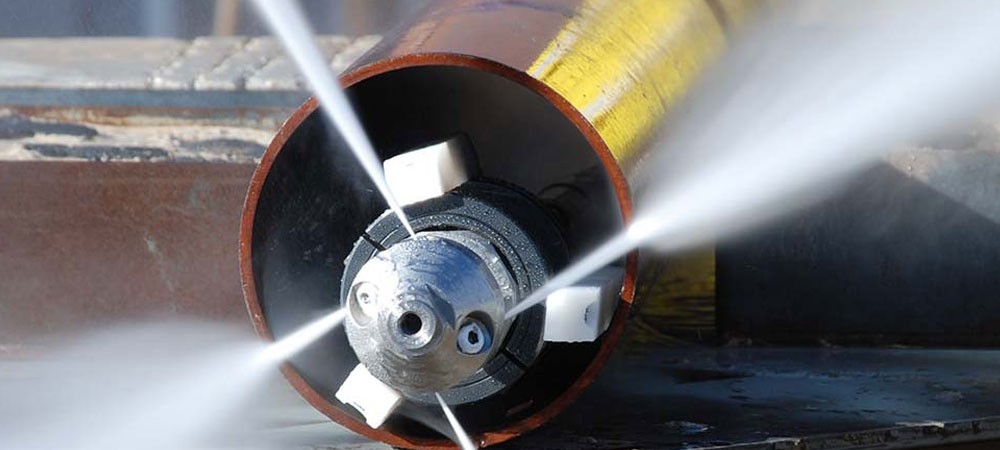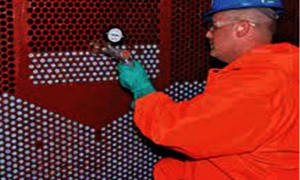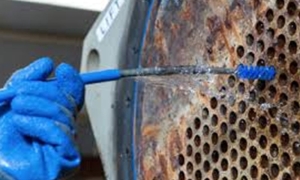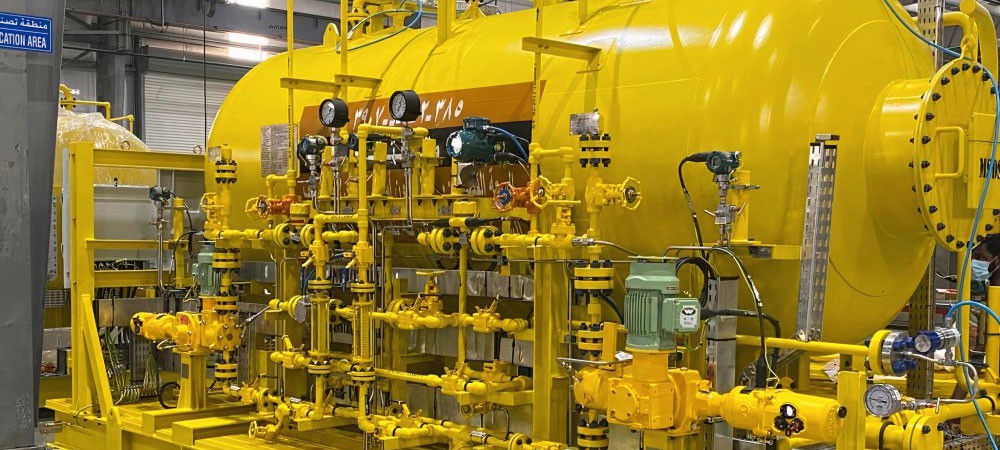Mechanical Tube Cleaning

Mechanical Tube Cleaning
Today's industry places great importance on protecting the health and well-being of both its employees and the environment. Managers in chemical plants and refineries have been asked to find better and safer ways to clean their heat exchangers while minimizing the impact of wastewater.
An emerging trend in keeping heat exchangers clean is the use of mechanical pipe cleaners. These mechanical systems use a variety of shooting, brushing, and drilling methods combined with low-pressure water below 48 bar (700 PSI). These methods work safely and quickly to remove even the hardest-to-clean deposits.
As an alternative to current practices, these mechanical pipe cleaning systems offer a much smaller footprint than traditional high-pressure water methods and allow the equipment to be located much closer to the heat exchanger which further reduces congestion during overhaul.
By using less water and pressure, these mechanical pipe cleaning systems are much safer to use and generate much less wastewater than high-pressure water methods. Mechanical cleaning technology has proven to be safe, effective, and environmentally friendly.
No matter what type of heat exchangers or which industries they are being employed in, eventually, all these units will foul. As deposits are building up on the interior walls of heat exchanger tubes, so, too, is an insulating barrier forming on the tube wall that will interfere with heat transfer. While the type of deposits, their tendency to adhere to the tube walls, and their insulating value vary depending on the fluids or gases flowing within the tubes, the result is the same: a loss in productivity. As the heat transfer rate drops, so does the heat exchangers' efficiency. This loss of efficiency will not only negatively impact the unit's production capacity but will also drive up the cost of the final product. To reduce this impact and help keep production flowing at peak efficiency, heat exchanger performance must be monitored. If fouling is identified, the deposits must be removed. Outcomes are always improved when the characteristics of the fouling are determined as soon after performance declines are detected. While high-pressure water cleaning (hydro blasting) has historically been the method of choice for fouling mitigation in industrial markets, the use of mechanical tube cleaners with low-pressure water has been gaining popularity.
MECHANICAL TUBE CLEANING SERVICES
Mechanical Cleaning is our most commonly used tube cleaning method. The combination of machine, flexible shaft, and brush is often used to clean smaller bundles (>1000 tubes). Very popular in various industries.
Mechanical cleaning with a brush system is one of the most effective methods for cleaning (smaller) shell & tube heat exchangers. By this, we mean cleaning the inside of the tubes by means of a rotating brush method. The concept is simple, a tube cleaning system powers a flexible shaft, which then rotates a brush. Due to the rotating action of the brush, there is continuous friction on the tube wall, which will cause the pollution to quickly come off. In combination with a water flush, the pollution is flushed away immediately. The water also acts as cooling for the internal core of the flexible shaft, so that the outer mantle does not heat up.
Mechanical tube cleaning is fast, effective, and very simple to perform. As a result, the method is characterized as very user-friendly, and people can often carry out the work themselves. The technology is especially interesting for the following systems/installations:
- Water-cooled condensers/chillers.
- Process heat exchangers (often found within the petrochemical/process industry).
- Tubes of an Air fin cooler.
- Evaporator tubes of Air-cooled Chillers.
Think of systems from well-known suppliers and manufacturers, such as Trane, York, Carrier, McQuay, etc.
In principle, the tube cleaning systems can all be used from an internal tube diameter of 7,0 millimeters. Everything above is no problem. Please note that more accessories will be required for various internal diameters. This is because different diameters of brushes and shafts are available, to be able to clean any diameter of tube. In addition, it is important to choose what kind of tube cleaning machine you use, whether should it be powered by air or electricity, etc. You can read more about this in the specific categories listed.
- Can be used from an internal tube diameter of 7,0 millimeters and up!
- Can be used for any length - just a matter of the right accessories.
- Brushes are available in various materials including nylon, brass, stainless steel, etc.
- Can be used for any industry - various types of tube cleaning systems are available.
The mechanical brush method allows you to remove different types of deposits. In general, the focus is more on light to medium pollution. But with the right brushes, heavier types of pollution can also be removed. Think about:
- Silt, mud, and algae.
- Biofilm (slime).
- Calcium carbonate.
MECHANICAL TUBE CLEANING SERVICES
Mechanical cleaning of an installation is one of the most common methods to clean a tube bundle internally. The concept is simple, a machine drives the flexible shaft, which in turn rotates a brush. Due to the rotating action of the brush, there is continuous friction on the tube and the deposits will quickly release. Due to the combination of a rotating brush and a water flush, the pollution is also flushed away immediately. The water furthermore acts as cooling for the internal galvanized, steel core of the flexible shaft. This way the nylon outer layer stays intact, even during usage.
The standard speed of Tube Cleaning Machines is 862.5 RPM. This is the ''sweet spot'' when it comes to cleaning. There are other systems that have variable, speeds, available. Watch the video below for a short explanation:
Advantages of mechanical tube cleaning:
This cleaning and maintenance method has some major advantages. The biggest ones are:
- Minimum wastewater during cleaning
- Optimal cleaning effect, due to continuous friction.
- Very cost effective due to (relatively) inexpensive materials
- Highest safety, the lowest risk of damages or injuries (both for the operator as well as the system)
Minimum Wastewater: Tube cleaning systems use just a little bit of water because it is only used for cooling the shaft's internal core and for flushing the deposits out of the tube. The brush is the main cleaning principle. Due to this fact, tube cleaning systems use very minimal amounts of water. When for instance compared to high-pressure cleaning.
Optimal cleaning effect: Tube cleaning brushes are matched to the tube's inner diameter. Sometimes, they are even used in an oversized manner. Which allows for continuous friction with the tube. This is by far the best method for removing pollution on the tube wall(s). You can simplify and compare it to cleaning a car. A high-pressure lance removes the deposits on the surface but does not interact with the actual fouling which is deeper attached to the surface. Simply apply a brush and the deposits come off instantly. The same applies to mechanical tube cleaning.
Cost-effective: A complete tube cleaning set-up/kit is not expensive when you look at the advantages, lifetime, and decreased downtime. We offer tube cleaning kits starting from 2500,00 and up. Depending on how many brushes, flexible shafts, and accessories are needed. Still, the costs are extremely low, when compared to high-pressure systems or trucks. Also, this equipment is very easy to use and can therefore also be used by internal staff. Removing the need for a third party to perform the cleaning. Which also saves time, scheduling, and costs. Hence the reason that end customers mostly choose mechanical tube cleaning packages.
High safety: Because all the equipment is designed to operate on low pressure, there is no risk of damaging the tubes internally or the operator. Which is often seen when high-pressure equipment is used with +200 bar pressure. High pressure can lead to serious damage and even leaks in the tube walls when not used carefully. This is often seen, when weaker tubes are cleaned, such as Cu/Ni materials. With this method, the only moving part is the brush, which has a rotating effect. This cannot damage the system itself or the operator when used under normal circumstances.






